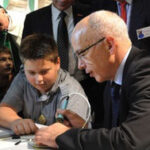Video-Clip
The first contact with amateur radio
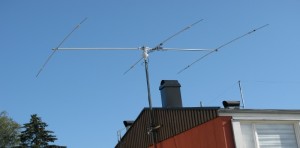 Amateur radio is a technical hobby that brings together people interested in electronics and communication. Probably almost everyone has come “in contact” with amateur radio, consciously or unconsciously. If you walk with open eyes through towns and villages and look attentively over the rooftops, you will usually succeed quickly. Amateur radio stations require antennas, wires, vertical rods or conspicuous, often quite extensive constructions. Amateur radio operators are open and happy to answer questions. Personal contact with an active amateur radio operator, who is sure to be happy to provide information and grant access to the radio station, is ideal.
Amateur radio is a technical hobby that brings together people interested in electronics and communication. Probably almost everyone has come “in contact” with amateur radio, consciously or unconsciously. If you walk with open eyes through towns and villages and look attentively over the rooftops, you will usually succeed quickly. Amateur radio stations require antennas, wires, vertical rods or conspicuous, often quite extensive constructions. Amateur radio operators are open and happy to answer questions. Personal contact with an active amateur radio operator, who is sure to be happy to provide information and grant access to the radio station, is ideal.
Local clubs are also ideal contact points. Addresses and websites of regional clubs can be found here. Inquiries can also be directed to the USKA secretariat. In any case, let them know where you live so they can direct you to the nearest contact point with information.
How to become a radio amateur
Many of the amateur radio operators came across this exclusive hobby quite by chance. Others got started through professional training, and still others first came into contact with wireless communications as part of military training. Everyone has their own personal career path.
 Amateur radio operators have to pass an examination as the basis of their activity. In Switzerland, the exam must be taken at the Federal Office of Communications (OFCOM) and covers the basics of electrical engineering and electronics as well as regulations on the construction and operation of the radio station.The necessary knowledge can be acquired either in appropriate schools, in correspondence courses or by attending courses with mostly weekly lessons, as offered by some sections of the USKA or other groups.
Amateur radio operators have to pass an examination as the basis of their activity. In Switzerland, the exam must be taken at the Federal Office of Communications (OFCOM) and covers the basics of electrical engineering and electronics as well as regulations on the construction and operation of the radio station.The necessary knowledge can be acquired either in appropriate schools, in correspondence courses or by attending courses with mostly weekly lessons, as offered by some sections of the USKA or other groups.
For activity on shortwave, proof of ability to pick up and give Morse code has not been required since 2003. Nevertheless, Morse telegraphy continues to be maintained as an extremely efficient mode of operation and enjoys widespread use.
Further information: “How to become a radio amateur?”
Amateur radio is very diverse
It is hardly possible to give a complete description of the possibilities that amateur radio opens up to active people. On this page we provide aspects of individual areas as well as links to further sources of information.
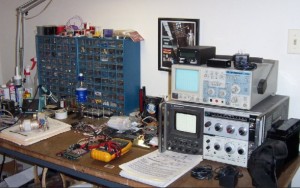 Amateur radio is a field of experimentation from which pioneering technologies and methods of information transmission have emerged again and again in the past. This has not changed since the beginnings of wireless communication until today. Since the invention of Morse telegraphy and radiotelephony, many new digital forms of wireless communication have emerged in recent decades. The fact that a radio connection across continents is possible even with little technical effort fascinates us again and again.
Amateur radio is a field of experimentation from which pioneering technologies and methods of information transmission have emerged again and again in the past. This has not changed since the beginnings of wireless communication until today. Since the invention of Morse telegraphy and radiotelephony, many new digital forms of wireless communication have emerged in recent decades. The fact that a radio connection across continents is possible even with little technical effort fascinates us again and again.
The computer freak will find opportunities for development here as well as the gifted hobbyist. One of the exclusivities of this hobby is the possibility to build and operate electronic devices by oneself. This self-building used to have a very high value, but today it has been largely replaced by a very extensive commercial offer. However, the radio amateur is still a tinkerer and “inventor” today. Even the construction of one’s own radio station requires creativity and the development of one’s own ideas for the selection of equipment and the construction of antennas.
For many, this hobby is ideal to cultivate foreign languages. However, there is also the possibility to get in touch with other amateur radio operators all over the world without knowing the language of your partner. The key to this is Morse code, or telegraphy. See also “Amateur Radio Practice / Basics“.
The radio station
Every radio amateur builds the radio station according to his personal ideas and possibilities. The variety of variants is inexhaustible. Thus there is as a minimum variant the small radio, which waits in a corner of the dwelling completely inconspicuously for its employment. Lucky is the amateur who has his own room for the radio station. Such rooms radiate a mixture of coziness and fascination that must be experienced. However, all variants have something in common: The technical components were selected and purchased with a lot of expertise and are cherished and cared for. Often, both very modern equipment and nostalgic transceivers can be found at the same station. There are hardly two radio stations with an identical technical setup.
How expensive is a radio station? This is a frequently asked question. It is possible to build a functional station with relatively little effort by using used equipment (second hand) and simple antennas. There are no upper limits. Everybody decides for himself how much he invests, just like buying a car.
By the way: The picture of the amateur radio operator, who sits with headphones on until deep into the night at a dimly lit radio station, is not so wrong!!!

The operating modes
Under the modes of operation we understand the different technical possibilities of the information transmission.
The oldest mode of operation is telegraphy (Morse code). The Morse code, invented around 1840 by Samuel Morse, is still used today in unchanged form. Here, internationally standardized abbreviations are used, so to speak an “amateur radio Esperanto”. This makes it possible to keep the time needed to transmit messages very short. In addition, people can communicate with each other who cannot communicate with any common language. Here is an example:
Telegraphy: tnx fer ufb qso / hpe cuagn / best 73
Plain text: Thank you for the excellent connection / I hope to meet you again / best regards
Why is telegraphy still so relevant today?
A short excursion into computational basics that never change: The bandwidth of a telegraphy signal is only about 10% of the bandwidth required for a voice radio (SSB) connection. The strength of the signal at the remote station is called field strength. With telegraphy we need only 1/10 of the transmit power to be received with the same field strength. Another interpretation is: With telegraphy and a certain transmitting power we bridge distances which are not possible with voice radio. The technical effort for generating a Morse signal is much lower than for processing the modulation of voice radio. Lovers of small transmitting power (QRP) are therefore preferentially found in telegraphy.
Telephony, also called voice radio, is the communication in open speech. Here, technical development has replaced amplitude modulation (AM) with single sideband (SSB). Frequency modulation (FM) is found preferentially on frequencies above 144 megahertz and in some areas of the 10m band. Connections in voice radio require appropriate language skills from the parties involved.
The digital modes of operation are developments that only became possible in their diversity with the spread of computer technology. AMTOR, PACTOR, Packet Radio, BPSK and teletype (RTTY) are only some of them. Some of them are characterized by the fact that very large distances can be covered with minimal transmission power. One of the newest operating modes is “FT8”, with which connections can still be realized whose signal lies deep in the noise. This fact has led to an explosive spread of this operating mode starting in 2017. – A very special digital operating mode is the transmission of colored pictures by means of amateur radio television (SSTV) on short wave.
Amateur radio serves the public
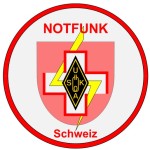 Amateur radio operators have exclusive skills. Various organizations therefore recruit their personnel from our ranks. Certain special units of the army, for example, consist of a majority of amateur radio operators. Many of our colleagues have been on duty somewhere in the world for the International Red Cross ICRC or the Swiss Disaster Relief. Many times amateur radio operators were able to organize help in emergencies worldwide or to ensure the connection between disaster sites and emergency forces. Members of the Union of Swiss Shortwave Amateurs USKA as well as organizations in other countries have organized themselves regionally and nationwide in the field of “emergency radio”.
Amateur radio operators have exclusive skills. Various organizations therefore recruit their personnel from our ranks. Certain special units of the army, for example, consist of a majority of amateur radio operators. Many of our colleagues have been on duty somewhere in the world for the International Red Cross ICRC or the Swiss Disaster Relief. Many times amateur radio operators were able to organize help in emergencies worldwide or to ensure the connection between disaster sites and emergency forces. Members of the Union of Swiss Shortwave Amateurs USKA as well as organizations in other countries have organized themselves regionally and nationwide in the field of “emergency radio”.
Further information/publications |
| Das neue Handbuch für den DX-er. Autor Bryce K. Anderson, K7UA. Deutsche Übersetzung Manfred Hübsch, OE5HIL. Version deutsch Januar 2015. Quelle: k7ua.com |
| Verordnung des BAKOM “Bundesamt für Kommunikation” über Frequenzmanagement und Funkkonzessionen / Kapitel 2, Abschnitt 2 |
Autor Josef HB9CIC
Version 17.3.2018
| Informationen zum Amateurfunk und zur USKA | ||

|
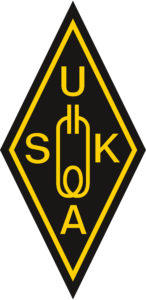
|
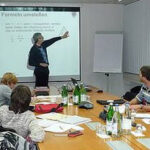
|


